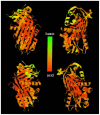The hidden side of SERPINB1/Leukocyte Elastase Inhibitor
- PMID: 27422329
- PMCID: PMC5610702
- DOI: 10.1016/j.semcdb.2016.07.010
The hidden side of SERPINB1/Leukocyte Elastase Inhibitor
Abstract
SERPINB1, also called Leukocyte Elastase Inhibitor (LEI) is a member of the clade B of SERPINS. It is an intracellular protein and acts primarily to protect the cell from proteases released into the cytoplasm during stress. Its role in inflammation is clear due to its involvement in the resolution of chronic inflammatory lung and bowel diseases. LEI/SERPINB1 intrinsically possesses two enzymatic activities: an antiprotease activity dependent on its reactive site loop, which is analogous to the other proteins of the family and an endonuclease activity which is unveiled by the cleavage of the reactive site loop. The conformational change induced by this cleavage also unveils a bipartite nuclear localization signal allowing the protein to translocate to the nucleus. Recent data indicate that it has also a role in cell migration suggesting that it could be involved in diverse processes like wound healing and malignant metastases.
Keywords: Apoptosis; Cell migration; Inflammation; L-DNase II; Leukocyte elastase inhibitor; Murine neutrophil elastase inhibitor; Serpin B1.
Copyright © 2016 Elsevier Ltd. All rights reserved.
References
-
- Silverman GA, Whisstock JC, Askew DJ, Pak SC, Luke CJ, Cataltepe S, Irving JA, Bird PI. Human clade B serpins (ov-serpins) belong to a cohort of evolutionarily dispersed intracellular proteinase inhibitor clades that protect cells from promiscuous proteolysis. Cell Mol Life Sci. 2004;61:301–325. - PMC - PubMed
Publication types
MeSH terms
Substances
LinkOut - more resources
Full Text Sources
Other Literature Sources
Miscellaneous




